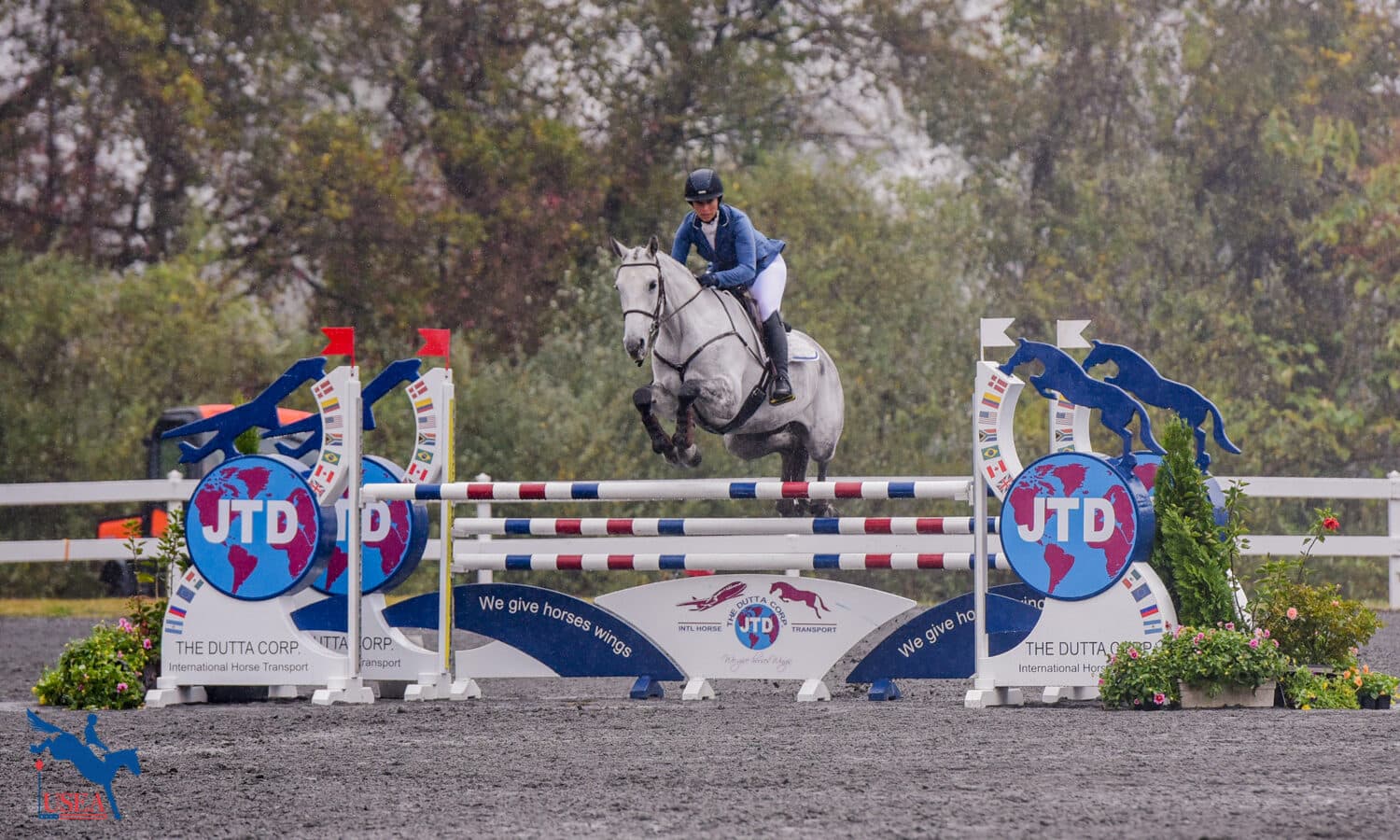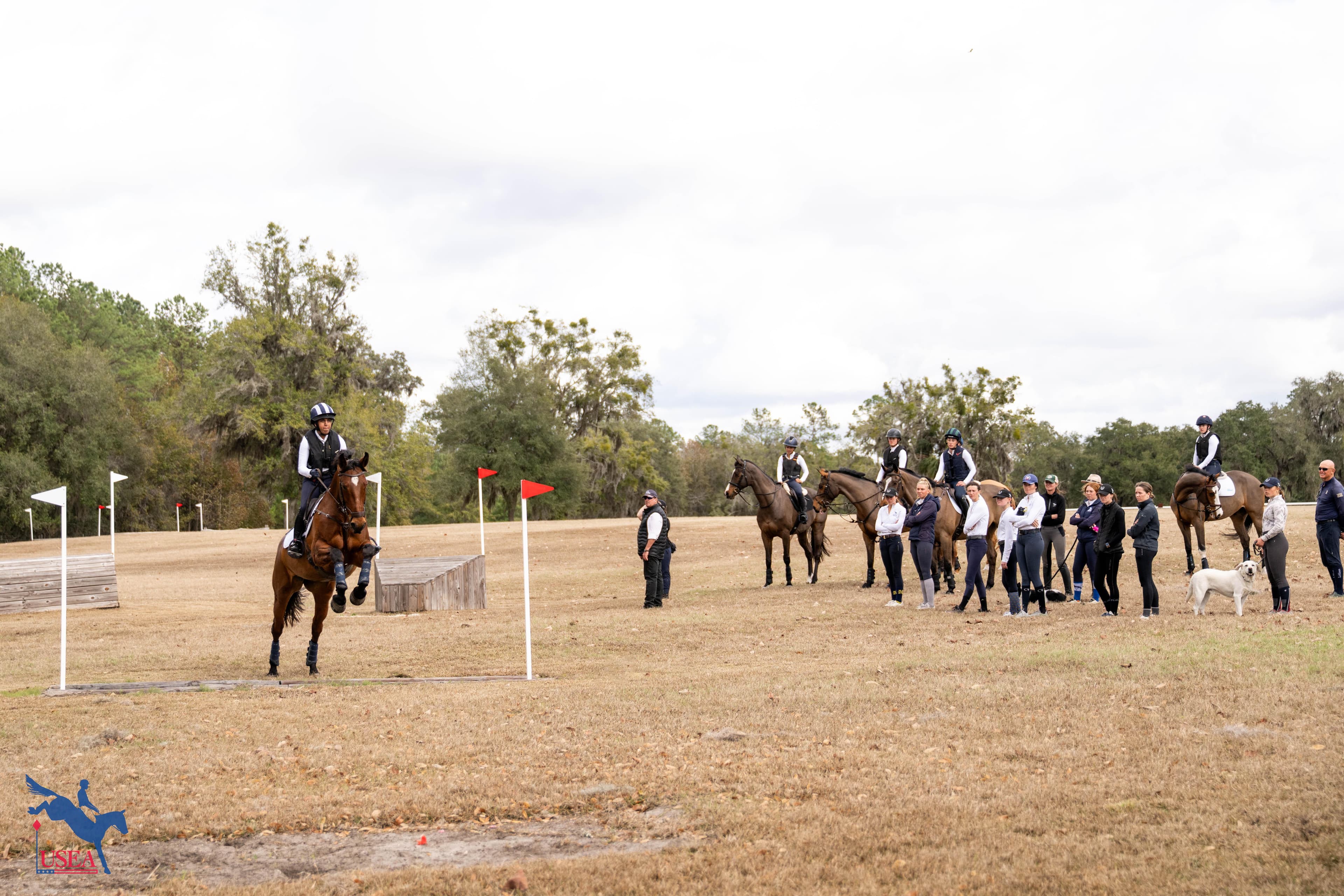Grid Pro Quo with Alyssa Peterson

Ready to spice things up this winter training season? Do you want to use being stuck in the arena as an opportunity to fine tune your riding? In this series, we are revisiting some of our favorite Grid Pro Quo articles from Eventing USA to help you use the off-season to your advantage and keep you and your horse in tip-top shape for when it's time to get back out there. Click here to check out other past Grid Pro Quo exercises!\
WHY:
From the time we begin jumping, we are always working on perfecting the canter. Throughout my career I’ve been lucky to train with a variety of top professionals and each had their tried and true method for developing the right canter to jump a clear round. The best instructors have their own methods for helping their students recognize this “perfect” canter. The challenge is that every horse and rider are different, so as a trainer and instructor you must be ready to adapt your methods to help each individual succeed.
While this exercise seems simple on paper, one of the reasons why I love it is because it is so adaptable to a variety of horses and riders. Depending on how you set it up, you can use it for any level horse or rider. From simple rails on the ground, to quite large verticals, the possibilities are endless.
The simplicity of it allows the riders to concentrate on their own position, while the exercise works your horse into a nice uphill rhythm. Regardless of your level, it’s never a bad idea to spend a little time concentrating on your own position. I will often leave this set up on the long side of the arena, and then set up a few other jumps so that I can incorporate a little coursework into my jump school, but always have this simple gymnastic to come back to help reset the canter if needed.
HOW:

Regardless of the level of the horse I am riding or the student that I am teaching, I will always start with the poles on the ground. If I’m working with a particularly green horse or rider, I will take the time to walk through the line of poles on a long rein a time or two. Basically I’m looking for the horse AND rider to take a breath and walk through the poles with total relaxation.
From here I will pick up the trot and make sure that the horse is able to have some adjustability within the gait. I want to make sure that when I put my leg on and post higher that the horse moves forward and lengthens their strides, and that when I sit tall with a half halt that the horse sits back on their hind end and shortens their stride. With the 10-foot distance between the poles, you will need a nice forward trot to successfully make it through, and most importantly you will need to stay up with your horse throughout the poles so that they are able to take big reaching steps without any interference from their rider. I have found that with young horses in particular, that this simple trot pole exercise really gets them thinking and really helps them learn to stay balanced while also staying forward.
Once I’ve completed the warm up, I will raise the first pole to make a small vertical and jump it a few times at the trot, but always canter away. The nice part about having the rails on the ground following the first jump is that they help to naturally keep the horse in the same rhythm after the jump. If you are riding a young horse, know that they will most always take a hard look at the poles after the trot fence, so be sure to keep your leg on!
I really believe that it is great to practice trotting fences, as any rider positional errors will come out more when you do. One of the biggest issues I see when teaching is that riders will often get antsy and jump ahead of their horse. Since you are trotting in, it gives you the time to concentrate on your own position and most importantly wait for your horse to jump up to you.
Once the horse and rider are confidently and competently jumping through this simple exercise I will start to raise the rest of the fences, starting with the third and then the fifth verticals. Most often, I will keep these jumps to raised cavaletti height – 18" or less. Once you have the fifth jump set up, you can start approaching the exercise from both directions. Just be prepared for your horse to take a peek at the exercise the first time through in the new direction.
From here, I will set up the second and fourth jump to the competition height appropriate for the horse and rider, while leaving the first, third and fifth jumps at cavaletti height. This is where the exercise starts to really work your horse. The 9' entrance rail helps you to place your horse close to the base of the first jump, and the “odd jumps” help create scope to your horse’s step. And the rider will benefit from the repetitive nature of the exercise to really be able to concentrate on their own position over the series of fences.
The next version of the exercise is to make it a series of bounces, where the jumps will get to 2'6" at most, but should stay quite low regardless of your level. Any series of bounces such as this will really put a horse onto their hocks. The rider needs to simply concentrate on staying tall and keeping their leg on. As you approach the series of bounces, your only thoughts should be of keeping your body still and allowing your elbow to follow your horse’s mouth. Your horse should be doing all of the work underneath you, and as their rider, you need to give them the ability to do so.
I have found that this is the perfect exercise for any rider that is apprehensive about putting their leg on for fear that their horse will run off. The bounces make it nearly impossible for a horse to run through – although it has been done! – so the rider can take their time to work on their own skills.
The final variation of this exercise is to leave the second and fourth jumps quite small, but then raise the first, third and fifth jumps to your competition height. This effectively sets up a triple combination for you in the arena, which is really only appropriate for Training level pairs and up. This variation not only works on getting your horse to rock back on their hind end, but it works to get both the horse and rider confident in getting close to the base of the jump.
From here, you have a few choices. If this is your first time working through this exercise and your horse has tried hard, you can call it a day and take them on a hack. If you’re coming back to this exercise a second or third (or fourth!) time, you can move on to jumping a small course set up in the rest of your arena. And if you ever feel as though your horse is getting away from you, or not respecting your half halt, you can simply come back to the exercise to help you re-set your canter.
About Alyssa Peterson
Alyssa Peterson is an Advanced level event rider who grew up surrounded by horses on her parents' farm in Maryland and got her start in Pony Club earning her ‘A’ rating. She went on to compete her family's homebred Stormin’s Barbie to Advanced and was on Area II's silver medal Young Riders CH-Y2* team. Peterson enjoys breeding, competing, and developing young horses to their full potential. She is currently starting her third generation of homebred eventers with Stormin' Truth having completed the Fair Hill and Jersey Fresh CCI3*-L and R-Perfect Storm has moved up to CCI3*-S. Peterson’s purpose in teaching and training is to develop confidence in both horse and rider that will lead to success. She has had the help of great trainers including Samantha Allan, Lucinda Green, Marja Sandburg, Jimmy Wofford, Sharon White, Britta Johnston, and Gavin Moylan and loves to pass on their wisdom in her teaching.













